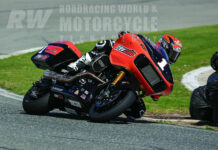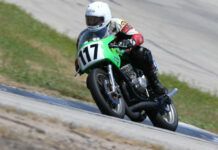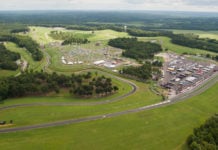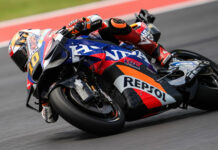Copyright 2003, Roadracing World Publishing, Inc.
This just in from AMA Pro Racing’s Ken Rogers, in response to our post, “3/11/2003 And Now A Very Good Question About The Daytona AMA Superstock Race, And Transponder Scoring Of Close Finishes.”
Editor, roadracingworld.com:
Thanks to John Kos from Albuquerque for your observations regarding the use of transponders in timing and scoring. Your calculations are correct that at approximately 180 mph a .009 margin of victory equates to about 2.34 feet. With a physical margin of victory of about 2″ – 3″ the actual time gap should be more in the order of .000631312 seconds. Our timing system is accurate to .00010 seconds and we display times rounded up to 1/1000 of a second. The reason for the .009 margin is due to the difference in placement of the transponders. This difference in transponder placement may have an effect on a finishing margin but it would make no difference when it comes to qualifying. Each rider is timed exactly the same lap after lap so his transponder placement is only relative to himself.
Establishing a reasonable yet effective location for the transponders can be a challenge. Automobile racing organizations such as NASCAR and IRL can mandate a specific distance back from the front bumper of a car for transponder placement. This is a very exact distance such as 24″ and this is checked during technical inspection. Because most of the chassis and body designs are very similar within these series it is easier to achieve a standard location. In the AMA Superbike Championship events at Daytona we had 19 different models of motorcycles and we will have even more when the Formula Xtreme class is added at Fontana. Add to this the various bodywork manufacturers and it becomes very difficult to establish one, universal location to mount a transponder that works for everyone.
Other factors come in to play such as the orientation of the transponder and proximity to electronics and carbon fiber. The TranX 260 and TranX Pro transponders that we use are more accurate when positioned vertically. The performance of the transponder can be inhibited if it gets buried among a cluster of electronics and they definitely do not like carbon fiber. This is why in the World Superbike Series race officials hand you a transponder and ask you to mount it wherever it works best.
At the Dunlop Tire Test this past December we began testing the TranX Direct Power transponders. This transponder is about 1/3 the weight and size of the standard TranX 260 and TranX Pro transponders because it does not have a battery. The transponder runs on the 12 volts from the motorcycle’s on-board battery yet only draws about .5 mw. Because it is required to be wired into the electrical system we asked the teams to experiment with different locations. As this new transponder is smaller in size it is easier to find space within the motorcycle’s fairing. Most of the teams using these have them positioned up inside the front fairing in a spot that is too small for our standard transponder and bracket.
If we could specify one location that is ideal it would be on a front fork tube just above the axle bolt. This would put the transponder in a location that is close to universal in relationship to the front edge of the front tire. However, this may not be suitable for everyone.
The timing and scoring system that we use is manufactured by AMB of The Netherlands and is the same hardware used by the Indy Racing League, CART, NASCAR, World Superbike and MotoGP series. Moreover, we are just one of three customers in the world using their new TimeGear timing software. AMB timing systems have proven to be the most reliable and accurate systems available.
Because there is always the possibility of a discrepancy in the transponder timing for determining finishing margins, we have established a number of additional contingencies. As a backup, and as a matter of procedure, we operate a video camera at the finish line which we start recording at the halfway mark of the race. Not only will we review close finishes between first and second place but we will take a look throughout the field at any other close finishes. In addition we have made arrangements with the television production crew to be able to review their video tapes of the finish as well. In the case of the Superstock Final we took a look at both to reconfirm the transponder timing. Finally we have our manual scorekeepers who, in this case, unanimously scored Tommy Hayden as the winner.
So to John from Albuquerque and other readers who may have had the same observation I hope this helps to answer your question. As more teams and racers choose to acquire these new direct power transponders it will become easier for us to find a universal location that is safe, functional and practical for everyone. And our current transponder placement continues to be reliable and accurate for qualifying and racing.
Ken Rogers
Director of Timing and Scoring
AMA Pro Racing
AMA Pro Racing Responds To Questions Regarding Transponder Scoring At Daytona
AMA Pro Racing Responds To Questions Regarding Transponder Scoring At Daytona
© 2003, Roadracing World Publishing, Inc.






